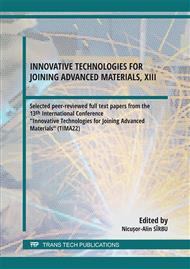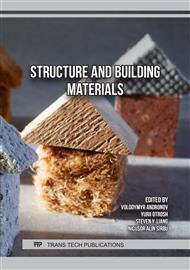p.63
p.69
p.75
p.85
p.99
p.105
p.113
p.121
p.127
Analysis of Mechanical Performance of Cementitious Materials with Spent Garnets as Fine Grain Aggregate Partial Replacement
Abstract:
The present research aims to simultaneously have positive contribution in two environmental issues identified on global scale, but also locally, in Romania: the waste generation due to industrial processes, on one hand, and on the other hand, the exhaustible natural resources constant increasing demand and consumption, in the construction industry as well. The use of abrasive waterjet (AWJ) sand in specific industries, for material processing purpose, represents an advantageous and efficient methodology, with increased domain of applicability and experiencing a significant development and improvement in the last years; still, besides the numerous benefits of the AWJ cutting and material processing techniques, they also generate collateral by-products, mostly converted into wastes: the abrasive materials (Garnet Sands) used during the AWJ cutting generate a sludge, generally unutilized and randomly deserted into damps (Spent Garnets, SG). In the same time, the construction industry and the corresponding mortar and concrete production segments, present accelerated growth, associated with global population fast increase (mainly in urban poles) and also with the industrial drive. The population growth and the industry expansion demand the corresponding infrastructure, civil, industrial, agrozootechnical, road and energetic, etc., leading to related request for building materials, concrete and natural resource consumption, like aggregates. This was the context which induced the idea of potentially valorizing the SG industrial by-products, generated by the local AWJ cutting industry, into construction materials, namely fine grain aggregates substitution in mortar and concrete. In order to evaluate the waste compatibility to a typical composition of cementitious material, a regular mortar was developed, considered the Reference (R) and further partial substitution of the usual sand was performed, by using the Spent Garnet wastes generated by two local companies. The substitution percentage was established in accordance to the previous studies in the topic, and ranged from 10 to 50% with respect to the sand quantity in the Reference mix. The mechanical performance of the mortars was analyzed at specific ages, in order to establish the viability of the substitution: 7day-testing, 14-day testing, 28 day-testing. The first results of the experimental study, focused on mechanical and physical characteristics of the mixes, are clearly encouraging, leading to the conclusion that SG by-products could be efficiently integrated in concrete and mortar mixes, as partial replacement of the regular sand; thus, the study opens the path to a sustainable, preventive solution for industrial waste generation and natural resources consumption as well. The potential use of SG as aggregate partial replacement in pavement eco-blocks is also considered, as future direction of research.
Info:
Periodical:
Pages:
127-139
Citation:
Online since:
August 2023
Authors:
Price:
Сopyright:
© 2023 Trans Tech Publications Ltd. All Rights Reserved
Share:
Citation:



